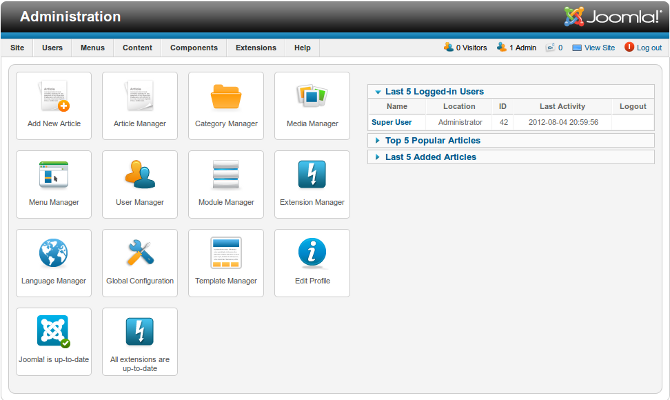Site Control Panel
From Joomla! Documentation
Start screen for back-end(Admin) control of an entire Joomla website. A user must have the correct priviledges for access.
How to access[edit]
The Control Panel can be accessed by logging into Joomla!'s back-end and should be thought as the main overview page for navigation to site controls and content creation. After logging in, the Control Panel will be displayed. To access the Control Panel from another area in the back-end:
- Select Site → Control Panel from the drop-down menu of the Joomla! Administrator Panel.
Description[edit]
The Control Panel provides access to many default Joomla! functions and features through a drop down menu bar, general notification area and clickable icons. A short list of some of the features from the Control Panel is:
- Create articles, categories, weblinks, modules and menus.
- Manage articles, categories, components, modules, templates, plugins, and menus
- Install templates, components, plugins, and modules
- Upload files such as images with the media manager
- Update Joomla core software and installed templates, plugins, components and modules.
Some of the direct links for quick access are to the Media, Menu, User, Module, Extension, and Language Managers as well as the Global Configuration. For a complete list of these icons and thier function, see below.
Screenshot[edit]
Icons[edit]
The icons available in control panel are:
- Add New Article. Opens the Add New Article page, where you can create new content.
- Article Manager. Opens the Article Manager, where you can manage all of your current articles.
- Category Manager. Opens the Category Manager, where you can create new categories, and publish/unpublish existing ones.
- Media Manager. Opens the Media Manager, which allows you to manage files on your web server. You can delete existing files or upload different ones from your hard drive. You can also create new directories on your web server's file system.
- Menu Manager. Opens the Menu Manager, where you can manage the current menus by creating new ones, deleting current ones, or directly managing each menu's subsequent menu items.
- User Manager. Opens the User Manager, which allows you to create/delete users, change passwords, modify language and time preferences, and switch which WYSIWYG editor the user has access too. You can also assign users to User Groups, limiting to which aspects of the site they have access.
- Module Manager. Opens the Module Manager, which controls the location and function of modules that are installed on the site.
- Extension Manager. Opens the Extension Manager, which allows you to add/remove add-ons that expand the functionality of Joomla!. Extensions are used to add capabilities to Joomla! that do not exist in the standard package. Hundreds of Extensions are available for Joomla!, with more being developed all of the time.
- Language Manager. Opens the Language Manager, which allows you to manage installed languages by setting one to be the site's default language.
- Global Configuration. Opens the Global Configuration. The global configuration has parameters that, when adjusted, will effect your entire Joomla! site. This makes the Global Configuration perhaps one of the most important areas in your Joomla! back-end. Here you can change many options including, but certainly not limited to: Time Zone, Language, Server Configurations, Session settings, and Meta Data.
- Template Manager. Opens the Template Manager: Styles screen. Tab access is also available to the Templates screen.
- Edit Profile. Opens the My Profile edit screen for the administrator.
- Joomla! Update Status Displays the current update status for the Joomla! installation. When an update is available, this button will link to the update installation screen.
- Extension Update Status Displays the current update status of installed extensions (if the extension supports this feature). When an update is available, this button will link to the installation screen.
Quick Tips[edit]
- Use the 'Add New Article' button to create articles quickly.
- Click on 'Recently Added Articles' and 'Popular Articles' to see which parts of your web site have most recently changed or are most often viewed, respectively.
- All areas accessed with the Control Panel icons may also be accessed from the drop down menus just above them.
